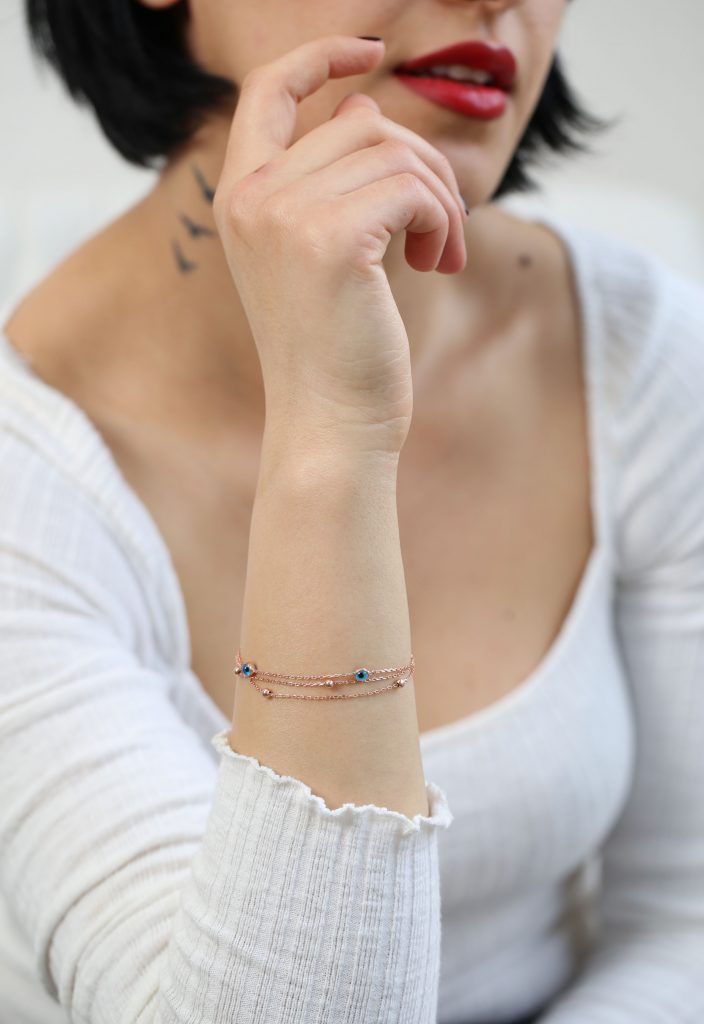The Evil Eye, a mystical and intriguing symbol, has traversed centuries and cultures, leaving an indelible mark on the world of jewelry. Its protective allure and captivating design have made it a timeless motif, particularly in the realm of silver jewelry. Join us as we journey through history to unravel the origins and enduring significance of the Evil Eye symbol in silver adornments.
- Ancient Roots: The roots of the Evil Eye symbol can be traced back to ancient civilizations, including Mesopotamia and the Mediterranean region. Believed to ward off malevolent glares and curses, the symbol served as a talisman for protection against unseen forces. Its presence in archaeological finds suggests its pervasive role in early beliefs.
- Mediterranean Mystique: The Evil Eye gained prominence in Mediterranean cultures, particularly in Greece and Turkey. Known as “mati” in Greek and “nazar” in Turkish, the symbol was incorporated into jewelry to safeguard wearers from envy and negative energy. Silver, with its lustrous sheen and malleability, became a favored medium for crafting these protective amulets.
- Symbolism and Design: The Evil Eye symbol typically features a concentric circle resembling an eye, often with a central pupil. The design varies, with some incorporating additional elements like spirals, dots, or vibrant colors. Silver’s versatility allowed artisans to create intricate and detailed Evil Eye jewelry, capturing both the symbolism and aesthetic appeal.
- Widespread Belief: The belief in the Evil Eye transcended geographical boundaries, influencing cultures from the Middle East to Europe. It became an integral part of folklore, with tales of its protective powers passing down through generations. Silver Evil Eye jewelry became a cherished tradition, worn as a daily talisman or given as a gift to express care and protection.
- Cultural Adaptations: Different cultures embraced the Evil Eye symbol, adapting its design to reflect their unique aesthetic sensibilities. From the delicate blue-and-white Evil Eye charms in Greece to the vibrant glass Evil Eye beads in Turkey, the symbol’s visual representation evolved while maintaining its fundamental purpose of safeguarding against negativity.
- Evolution in Modern Jewelry: In the modern era, the Evil Eye symbol has experienced a renaissance in the world of fashion and jewelry. Silver Evil Eye pieces are not only cherished for their protective qualities but also celebrated for their stylish and versatile designs. Contemporary jewelry designers often reinterpret the symbol, infusing it with a modern aesthetic to appeal to a broader audience.
- Celebrity Endorsement: The popularity of Evil Eye jewelry has been further propelled by celebrities who openly embrace the symbol. From fashion icons to Hollywood stars, the Evil Eye has become a sought-after accessory, elevating its status from traditional charm to a trendy and fashionable emblem.
- Artisan Craftsmanship: Silver’s enduring popularity in Evil Eye jewelry is due in part to the skill of artisans who handcraft these pieces. Intricate detailing, hand-etched designs, and careful attention to symbolism distinguish artisan-crafted silver Evil Eye jewelry, adding an extra layer of authenticity and charm.
As we gaze back through time at the intricate tapestry of the Evil Eye symbol in silver jewelry, we find a narrative woven with beliefs, traditions, and an enduring quest for protection. From the ancient civilizations that first embraced its mystical properties to the contemporary fashionistas who adorn themselves with its silver embodiment, the Evil Eye continues to watch over and captivate, proving that some symbols are truly timeless. The allure of the Evil Eye in silver persists, casting a gaze that transcends centuries and cultures, ever watchful and eternally stylish.

